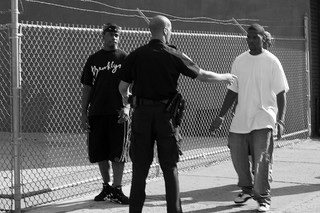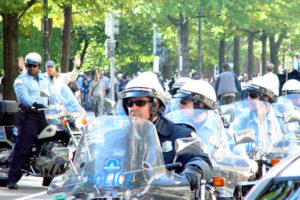The stop-and-frisk search is one of the most controversial police tactics in use — especially in New York City. Lately, stop-and-frisk practices have been in the news. A high-profile civil rights lawsuit, which alleges that the New York Police Department violated the constitutional rights of hundreds of thousands, is working its way through the federal courts in New York. This post will explain what a stop-and-frisk search is and under what circumstances police can conduct such a search. Our later posts will include how to pursue a claim for these constitutional violations.

Photo Taken by Flickr User Runs With Scissors
What is a Stop-and-Frisk Search?
A stop-and-frisk search is a limited search that occurs when police stop a person and frisk (or pat down) him or her for weapons or contraband. A stop is different from an arrest, and the rights of someone who is stopped differ significantly from those of someone who is arrested. A stop is considered to be only a “temporary interference” with a person’s liberty by law enforcement, whereas an arrest is the use of legal authority to deprive someone of his or her freedom of movement.
When someone is arrested in the United States, certain legal requirements are triggered. When the police arrest someone, they should give him or her the Miranda warnings prior to any questioning. But this is not the case when someone is merely “stopped” for the purposes of a stop-and-frisk search.
During a stop-and-frisk search, a person may be arrested if an officer uncovers evidence of a crime during the frisk. But if no evidence of a crime is found, the person must be released. Typically, a frisk is limited to patting down a person’s outer clothing to an extent only to ascertain whether there is evidence of a crime and their safety. If an officer feels what seems to be a weapon during the frisk, the officer may then reach inside the person’s clothing. A frisk differs from a full search (such as a search following an arrest), which may be much more extensive.
When Can Police Conduct a Stop-and-Frisk Search?
Another major difference between an arrest and a stop-and-frisk search is the standard applied by courts to determine whether each is permissible. In order to place someone under arrest, police are required to have probable cause. This generally means that police can make an arrest only when there is a reasonable basis for believing that a crime may have been committed. Police are not required to have probable cause to conduct a stop-and-frisk search. A lower standard, known as reasonable suspicion, is applied to stop-and-frisk searches. A reasonable suspicion exists when a reasonable person, under the same circumstances, would, based on specific and articulable facts, suspect that a crime has been committed.
Why are Stop-and-Frisk Searches Controversial?
There are many reasons why stop-and-frisk searches are controversial. One is the reasonable suspicion standard applied to stop-and-frisk searches. Over the course of several years, the United States Supreme Court became increasingly permissive about what constituted reasonable suspicion adequate to conduct a stop-and-frisk search. In a 1990 case, the Court upheld a stop based solely on an anonymous tip that described a certain car that would be at a specific location. Later, the Court retreated from this position. In a 2000 case, the Court ruled that an anonymous tip identifying a person who is carrying a gun is not, without additional reason, enough justification for a police officer’s stop-and-frisk of that person.
In addition to confusion about the reasonable suspicion standard, there is convincing evidence that stop-and-frisk searches are often conducted by New York City police officers on people who are innocent. This raises significant questions about the appropriateness (if not the constitutionality) of police conduct in these circumstances. Furthermore, an overwhelming majority of the people stopped and frisked in New York are black and Latino.
The stop-and-frisk practices of the New York City Police Department have been challenged in a class action civil rights lawsuit brought in the U.S. District Court for the Southern District of New York. In August, a judge issued a 198-page ruling in Floyd v. City of New York. The court held that the program was unconstitutional. The City plans to appeal the decision, although implementation of the trial court order, including officer re-training and complete street videotaping of police activity in one precinct per borough is going forward while the appeal is pending. Stop-and-frisk practices have also become a leading issue in the New York City mayoral race and will continue to be a central focus for whoever succeeds Michael Bloomberg.
Whether stop-and-frisk policies will change in New York City remains to be seen. What is clear, however, is that stop-and-frisk searches have become a hot-button legal, social, and political issue. These police encounters with mainly people of color reflect difficult issues about law enforcement and the role of race that will not be easily resolved.



